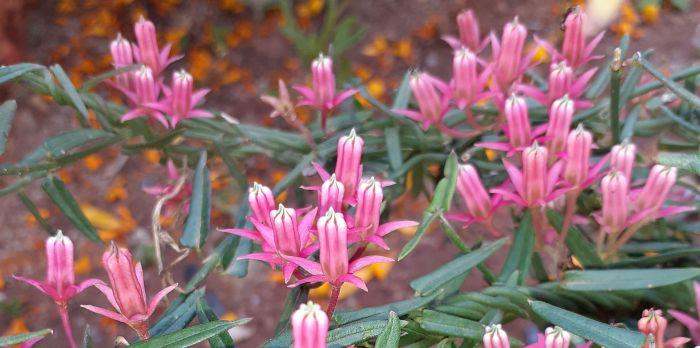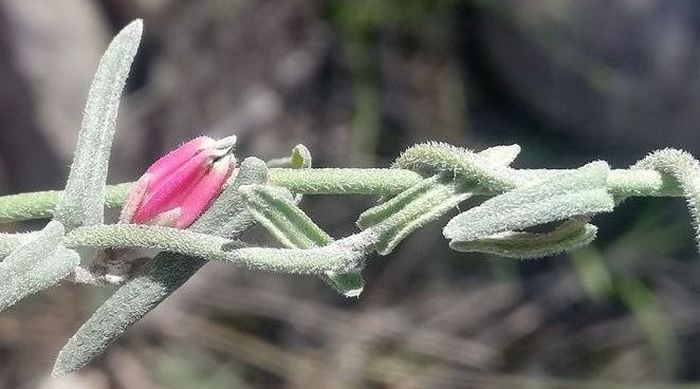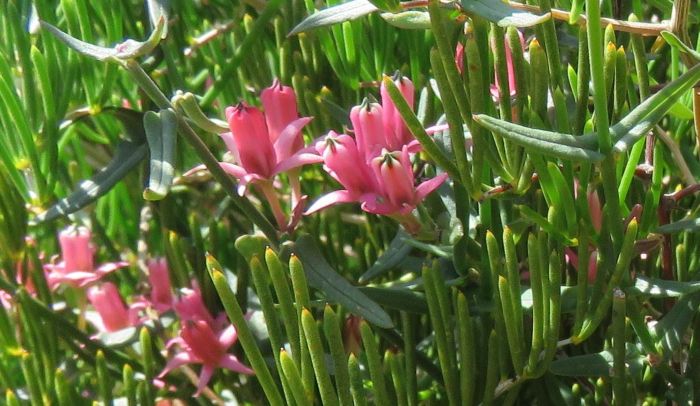Microloma sagittatum
Microloma sagittatum (L.) R.Br.
Family: Apocynaceae
Common names: firecracker vine, wax creeper (Eng.); bokhoring, bokhorinkies, bokmaellie, heuningblommetjie, kannetjie, melkblommetjie (Afr.)
Introduction
The uniquely attractive flowers of Microloma sagittatum draw attention to this otherwise insignificant, plain looking, slender climber that grows in between other shrubs.

Description
Description
Microloma sagittatum is a twining climber, with evergreen stems and opposite, grey-green, succulent, spear-shaped leaves, up to 30 mm long and 7 mm across, covered in minute hairs. The flowers are pinkish red and are borne in branched flower heads with 5 to 8 flowers each. Flowering time is from winter into late spring (June to September in the southern hemisphere). The forked fruit is a dehiscent follicle. Once ripe the fruit splits open along the seams releasing the brown seeds, each with long silky hairs.

Microloma calycinum frequently grows with M. sagitattum and is easily distinguished by the smooth stems and leaves and by the much twisted corolla lobes.
Microloma namaquense and M. tenuifolium are closely related but differ mainly in the different shape and texture of the corolla lobes.
Conservation Status
Status
This plant’s conservation status is assessed as Least Concern (LC) according to SANBI's Red List of South African plants. The population of the species is stable and is not endangered.

Distribution and habitat
Distribution description
Microloma sagittatum is found in the winter rainfall region, in the Little Karoo, Great Karoo and Namaqualand, in the Northern, Eastern and Western Cape Provinces, growing into shrubs. It grows in a variety of vegetation types, including Renosterveld, Fynbos and Succulent Karoo, and occurs in a range of soil types, mainly rocky, sandy and shale soils of arid areas, at altitudes of 10–1 300 m.
The population in the Karoo Desert NBG in Worcester is dependent on an average annual rainfall of 250 mm and winter temperatures reaching -1ºC. During the mild winter of the Little Karoo, the days are warm and pleasant even though the Swartberg and Langeberg Mountains are occasionally snow-capped. Winter temperatures rarely drop below zero, resulting in occasional mild frost, whereas average daytime temperatures are fairly high, reaching the mid-twenties. In summer the daytime temperatures could be as high as 44ºC with fairly high averages of between 25 and 30ºC. This population experiences much drier conditions than those on the higher reaches of the nearby mountains. Arid conditions are caused mainly by the rain-shadow effect of the Langeberg in the south. The annual rainfall varies from 125–300 mm, but it can be as high as 400 mm, owing to local orographic effects. This occurs when air masses are forced to flow from low to high terrain; as air rises over the mountains, it cools and water vapour condenses. As a result, it is common for rain to be concentrated on the windward side of mountains, and for rainfall to increase with elevation in the direction of storm tracks.
Vegetatively, this species, is rather variable in the size of the leaves and the degree of hairiness of the stems and leaves. As one progresses in an easterly direction, the plants become less hairy, with the most densely hairy plants in the west-coast sandveld vegetation and almost completely smooth ones on the margins of the Great Karoo, in the regions of Calvinia, Laingsburg and Port Albert.
Within populations the flowers vary, especially in size and shape, but also in colour, from pale pink to deep pink-red. It is interesting to note that M. sagittatum also has a white form (Bruyns, P.V. pers. comm. 2020).

Derivation of name and historical aspects
History
The genus name Microloma comes from the Greek mikros, meaning ‘very small’, and loma, meaning ‘edge or fringe’, referring to the tufts of hairs in the corolla tube. The specific epithet sagittatum comes from the Latin sagitta, meaning ‘a spear’, referring to the arrow-shaped, greyish green leaves.
The attention of the earliest collectors at the Cape, was drawn to the attractive, brightly-coloured flowers of both Microloma sagittatum and M. tenuifolium and both were known to Carl Linnaeus, but he called them Ceropegia. These were the only species known to him, but Carl Peter Thunberg and J. Franz Drège discovered more. In southern Africa Microloma has 10 species, 7 occur in Namaqualand and 3 in the Little Karoo. The fruit of the species has erect, paired follicles that resemble the horns of a buck, hence the Afrikaans common name bokhorings. The unique flowers, on the other hand, resemble a firecracker, hence the English common name, firecracker vine, is a suitable one.
Microloma sagittatum belongs to the Apocynaceae, the milkweed family. Unlike other species of the family, this genus does not exude a milky latex but a clear liquid when injured. It is the eighth largest family and has 94 genera and 787 species.
Four other noteworthy species of this genus are: Microloma calycinum (bokhorinkie) which has clusters of pink to red flowers with pointed petals and is found in Namaqualand; Microloma incanum (bokhorinkie) has two-toned clustered flowers, pink in the basal half and white in the upper half and is found in the Richtersveld and Namakwaland klipkoppe; Microloma namaquense (namakwakannetjies) has bright red, urn-shaped, loosely clustered flowers, with rounded petals and is found west of Springbok in Namaqualand; Microloma tenuifolium (kannetjies) has clusters of shiny, hairless, urn-shaped, orange to red flowers, with rounded petals and is found in the Western and Eastern Cape.

Ecology
Ecology
The main pollinators are sunbirds that visit the small, pinkish red, closed flowers, by piercing them, resulting in the pollen sacs attaching to the birds’ tongues. This is a uniquely specialised form of bird pollination. It was noted by Heath & Zielske that the Karoo lycaenid Warrior Silver-spotted Copper, Argyraspodes argyrasps, was strongly attracted to the pinkish red flowers and would be intensively nectaring on one plant at the same time. Ants also feed on the sweet nectar. The plants are heavily browsed by stock and game.
The fruits, which are paired follicles, mature in winter and spring (August to September),when they split along the centre seams and release the seeds. Each seed has long silky hairs which acts like a parachute and facilitates wind dispersal.
Fully grown plants are an indication of well managed veld. A fibrous root system anchors these plants to the top layer of soil.
Uses
Use
Bokhorings, is a popular veld food. The young fruits (known as follicles) are eaten fresh and have a milky sweet taste. Youngsters enjoy them as a snack. The flowers are also edible and are eaten fresh.
Plants would make lovely creepers in pots on mini trellises as the pinkish red flowers attract sunbirds (Milton, S. pers. comm. 2020). Since these plants are not easily grown from seed, they are not available from nurseries. It is best to have them growing in a natural veld area.

Growing Microloma sagittatum
Grow
Propagate from seed sown in autumn in a well-drained, loamy soil. Timing of sowing of seeds is a key factor in the success of the survival of the plants. Germination and seedling establishment require sufficient soil moisture and ideal temperatures. The best time to sow seeds in the Western Cape is just prior to the winter rains in March and April. This allows the seeds the maximum period of favourable conditions to establish before the harsh summer conditions set in. Studies have shown that seed of Microloma sagittatum and M. calycinum appear to have an inhibitor and will only germinate during the winter rainfall period. The seeds are quite recalcitrant and do not germinate readily (Bruyns, P.V. pers. comm. 2020).
The seed should germinate within 8 days of watering. They have 2 cotyledon leaves in the beginning and a single green stem that rapidly elongates seeking to twine. As a twiner with very few leaves, the plant must start life in the shade. After about 6 weeks the seedlings can be transplanted into loamy soil when they are 15 mm tall. Microloma is palatable to game and livestock and, therefore, gets browsed short if exposed. These climbers should be planted under bushes into which they can twine.
This winter-grower in its natural habitat grows in full sun. These plants are not frost hardy.
Its clusters of pinkish red flowers will attract attention together with plants like Arctotis fastuosa (namakwagousblom) with its reddish orange outer florets, Crassula deltoidea (kata-kiso), a low growing, grey-leaved succulent, Crassula rupestris (concertina plant) with its interesting overlapping leaves, Freesia refracta (klein karoo kammetjie) with its strong spicy scented, light yellow flowers, Gazania krebsiana (botterblom) with bright orange reddish flowers, Gladiolus venustus (kalkoentjie) with pink flowers and yellow markings on the lower half of the lower tepals, Lessertia frutescens (balloon pea) with its striking orange flowers, Osteospermum oppositifolium (skaapbos) with its yellow ray florets, Tylecodon wallichii subsp. wallichii (bandjiesbos) with its tree-like succulent bonsai appearance, and Dimorphotheca sinuata (Namaqualand daisy) sown in between to add some more colour.
Brown soft scale and white scale are pests found on the twining stems of these plants. Use a horticultural oil to smother these pests. Care should be taken not to spray when in flower.
References
- Bruyns, P.V. 1991. Notes on Microloma, a small asclepiad genus from western southern Africa. Asklepios. 52:72-74.
- Bruyns, P. & Linder, H.P. 1991. A revision of Microloma R.Br. (Asclepiadaceae - Asclepiadeae). Botanische Jahrbücher für Systematik 112(4):453-527.
- Clarke, H. & Charters, M. 2016. The illustrated dictionary of southern African plant names. Flora & Fauna Publications Trust, Jacana, Johannesburg.
- Foden, W. & Potter, L. 2010. Microloma sagittatum (L.) R.Br. National Assessment: Red List of South African plants version 2020.1. Accessed on 2020/09/05.
- Heath, A. & Zielske, J.F. 2015. Preliminary observations on the life history and behavior of the enigmatic lycaenid ‘Warrior Silver-spotted Copper’ Argyraspodes argyraspis (trimen, 1873). Metamorphosis 26: 97–101.
- Koekemoer, M., Steyn, H.M. & Bester, S.P. 2015. Guide to Plant Families of southern Africa. Strelitzia 31. 2nd ed., 2nd print. South African National Biodiversity Institute, Pretoria, South Africa.
- Manning, J. 2003. Photographic guide to the wildflowers of South Africa. Briza Publications, Pretoria.
- The Asclepiad Exhibition, Notes Matelea – Microloma - Ophionella. https://www.asclepiad-exhibition.org/Notes_Matelea-Microloma-Ophionella.htm Accessed 06/09/2020.
- Van Breda, P.A.B. & Barnard, S.A. 1991. 100 Veld plants of the winter-rainfall region: a guide to the use of veld plants for grazing. Bulletin no. 422. Dept. of Agriculture Development, Cape & Transvaal Printers for the Government Printer, Pretoria.
- Van der Merwe, H. in collaboration with Van Rooyen, G. 2010. Wild flowers of the Roggeveld and Tanqua. Business Print. Calvinia.
- Van Jaarsveld, E., Van Wyk, B-E. & Smith, G. 2005. Succulents of South Africa: a guide to the regional diversity. Tafelberg Publishers, Cape Town.
- Van Wyk, B.-E. & Gericke, N. 2000. People's plants. Briza Publications, Pretoria.
- Van Wyk, A.E. & Smith, G.F. 2001. Regions of floristic endemism in South Africa. A review with emphasis on succulents. Umdaus Press, Hatfield, Pretoria
- Vlok, J. & Schutte-Vlok, A-L. 2015. Plants of the Klein Karoo. Umdaus Press, Hatfield.
- Wikipedia. Microloma. https://en.wikipedia.org/wiki/Microloma Accessed 05/09/2020.
Credits
Shireen Harris
Karoo Desert National Botanical Garden
November 2020
Acknowledgements: the author thanks Marion Maclean and Steven Molteno for the use of their images and P.V. Bruyns for information on the genus.
Plant Attributes:
Plant Type: Climber
SA Distribution: Northern Cape, Western Cape
Soil type: Sandy, Loam
Flowering season: Spring, Winter
PH: Acid
Flower colour: Red, White, Pink
Aspect: Full Sun
Gardening skill: Challenging
Special Features:
Horticultural zones








Rate this article
Article well written and informative
Rate this plant
Is this an interesting plant?
Login to add your Comment
Back to topNot registered yet? Click here to register.